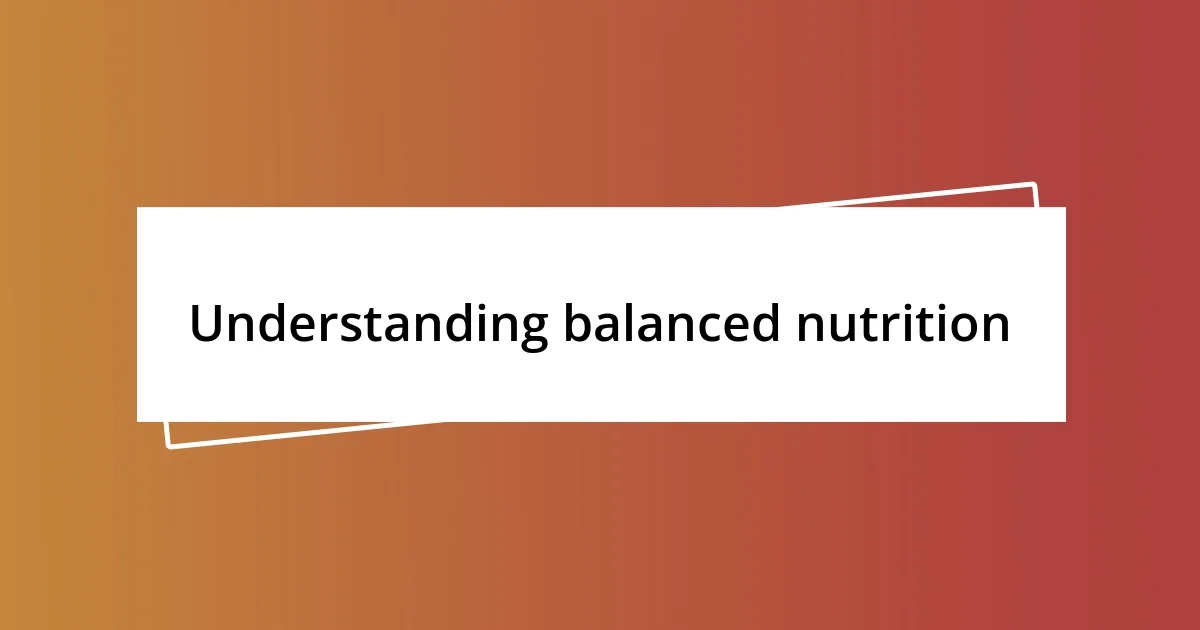Key takeaways:
- Understanding balanced nutrition involves recognizing personal dietary needs based on lifestyle, activity level, and health goals.
- Setting achievable nutrition goals is essential; they should be specific, measurable, realistic, and celebrated for motivation.
- Incorporating variety into meals and tracking progress can transform eating habits, making meals enjoyable and health-focused.

Understanding balanced nutrition
Balanced nutrition is all about finding the right mix of nutrients your body craves. I still remember when I first started my journey; it felt overwhelming to navigate the world of macronutrients—carbohydrates, proteins, and fats—and micronutrients like vitamins and minerals. It’s fascinating how every food group plays a vital role in our well-being. Have you ever noticed how your energy levels fluctuate based on what you eat?
For me, incorporating a variety of colorful fruits and vegetables into my meals was a game changer. I used to stick to the same few ingredients, but once I embraced diversity on my plate, I felt so much more vibrant. It’s almost like my body was cheering me on, saying, “Finally, you’re giving me what I need!” I believe that understanding balanced nutrition isn’t just about strict diets; it’s about listening to what our bodies truly need.
When I started paying attention to portion sizes, it opened up a whole new dimension of balanced eating for me. I learned that it’s not just about what you eat but how much you consume. There were times when I indulged a little too much, and I felt sluggish afterward, prompting me to reflect on moderation. What have your experiences taught you about the balance between enjoying food and fueling your body?

Identifying personal dietary needs
Understanding personal dietary needs is crucial in our quest for balanced nutrition. I recall sitting down with a nutritionist for the first time; it was an eye-opener. She helped me analyze my lifestyle, activity level, and health goals, thereby shedding light on the specific nutrients my body required. This initial assessment has since become a vital part of my routine whenever I feel a dip in my energy levels or shifts in my mood.
I often reflect on how different life stages change our dietary needs. For instance, during my training for a marathon, my focus shifted towards increasing my carbohydrate intake for energy. Conversely, when I was recovering from an injury, I prioritized protein to aid healing. It’s amazing how our bodies signal what they need, and I’ve learned to tune into those cues instead of following generic dietary advice.
Recognizing dietary needs isn’t just about numbers and nutrients; it’s a personal journey. I suggest keeping a food diary for a few weeks. This exercise not only reveals patterns in your eating habits but also highlights how certain foods influence your mood and energy. Have you ever felt low after a sugary snack? Tracking helped me pinpoint when I needed to swap out foods for better options, ultimately leading to a more balanced approach to eating.
| Aspect | Considerations |
|---|---|
| Activity Level | Adjust macronutrients based on physical activity, like increasing carbs for high-intensity workouts. |
| Health Goals | Tailor your diet for weight loss, muscle gain, or overall health based on personal objectives. |
| Food Preferences | Consider dietary restrictions or preferences (vegan, lactose-free) to ensure nutritional adequacy. |
| Aging | Adjust nutrient intake as you age; for example, you might need more calcium for bone health. |

Setting achievable nutrition goals
Setting achievable nutrition goals starts with a clear understanding of what you want to accomplish. I remember when I decided to cut down on processed foods. At first, the thought felt daunting. However, breaking this goal into smaller, actionable steps made it manageable. Instead of saying, “I’ll never eat junk food again,” I focused on gradually replacing one meal a week with something healthier. Little by little, these small changes set the foundation for a more nourishing lifestyle.
Here’s how you can set your own achievable nutrition goals:
- Be Specific: Choose clear targets, like “eat two servings of vegetables at lunch” rather than vague intentions like “eat healthier.”
- Make it Measurable: Quantify your goals, such as “drink eight glasses of water daily” instead of just “stay hydrated.”
- Stay Realistic: Understand what fits into your lifestyle. If you’re busy, don’t commit to cooking every meal from scratch right away.
- Set Timeframes: Give yourself deadlines, like “I’ll replace sugary snacks with fruit for one month.”
- Celebrate Progress: Acknowledge when you hit milestones, no matter how small. I still remember the pride I felt after sticking to my goals for just one week—it fueled my motivation!

Creating a meal planning strategy
Creating a meal planning strategy can genuinely transform your eating habits. I vividly recall the first time I plotted out my weekly meals. It felt tedious at first, but once I saw the colorful mix of ingredients laid out before me, I realized how empowering it was to take control of my nutrition. By dedicating just a short time each week to plan, I noticed I made healthier choices, reduced food waste, and saved money. Who wouldn’t want that?
When diving into meal planning, I suggest starting simple. One approach that worked wonders for me was theme days—like “Meatless Mondays” or “Taco Tuesdays.” This not only made it easier to decide what to eat but also added a fun twist to my meals. Plus, if I planned a specific theme, it became a conversational point at the dinner table. Have you ever noticed how food can spark delightful exchanges?
It’s essential to keep your meal planning flexible. For example, I learned not to stress if I didn’t stick to my plan exactly. Life happens! I remember a week when unexpected guests arrived, and my carefully crafted meals went out the window. Instead of feeling defeated, I just embraced the spontaneity and whipped up a colorful stir-fry with whatever veggies I had. That night felt lively and delightful, reminding me that balance also means enjoying delicious food in good company.

Incorporating variety into meals
Incorporating variety into meals is one of my favorite aspects of cooking. When I started mixing different cuisines and textures, it completely transformed my dining experience. For instance, I once prepared a Mediterranean-inspired dish with quinoa, roasted vegetables, and tzatziki sauce. The combination was not only visually appealing but also packed with flavors that kept me excited for every bite.
I often reflect on how easy it is to fall into a routine of eating the same meals over and over again. One time, after weeks of having oatmeal for breakfast, I experimented with overnight chia pudding topped with fresh fruit. It was a game-changer! By simply adding different toppings or trying a new grain, I realized meals could be delightful surprises rather than a chore. Don’t you just love it when something as simple as a sprinkle of nuts can elevate a dish?
I’ve found that incorporating a variety of colors on my plate not only makes meals more appealing but also ensures a beneficial mix of nutrients. A colorful rainbow of veggies, such as bell peppers, spinach, and eggplant, not only nourishes my body but also brightens my spirit. I always think, if my meal looks vibrant, it likely tastes just as exciting. How often do we overlook the joy of eating well? Making this small shift has brought a sense of adventure into my day-to-day meals, and ultimately, it’s about finding balance in a way that feels enjoyable.

Tracking progress and adjustments
Tracking my progress became a pivotal aspect of my journey toward balanced nutrition. At first, I started with a simple food journal, jotting down what I ate and how I felt afterward. It was eye-opening to see patterns emerge—like how those mid-afternoon snacks were often a response to stress rather than hunger. Have you ever noticed how your emotions influence your food choices?
As I reflected on my entries, I realized that adjustments were just as crucial as tracking. For example, I found that drinking more water made a significant difference in my energy levels and cravings. When I started incorporating a water tracker on my phone, it felt like I was setting little goals for myself daily. Every sip added to my sense of accomplishment. Isn’t it fascinating how small changes can lead to those “aha” moments in our health journeys?
Eventually, I moved to digital apps that offered detailed insights into my nutrient intake and macronutrient breakdown. Initially, it seemed overwhelming, but over time, I learned how to use that data to fine-tune my meals. I discovered I was missing out on enough fiber, which led me to explore high-fiber foods like lentils and chia seeds. What tools have you found effective in tracking your nutrition? Finding the right method made my journey feel less like a chore and more like an engaging project, fostering a deeper relationship with the food I embraced.

Overcoming common dietary challenges
One dietary challenge I faced was the temptation of convenience foods, especially during busy weeks. I remember a particularly hectic Monday when I grabbed fast food for dinner, feeling guilty afterward. That experience taught me the importance of meal prepping. Taking a few hours on the weekend to prepare healthy meals not only saved me time but also satisfied my cravings without the regret. Have you considered how a little planning could transform your week?
Another struggle was navigating social gatherings where unhealthy options were prevalent. I vividly recall a friend’s birthday party filled with sugary treats and greasy snacks. In those moments, I learned to be proactive—bringing my own nutritious dishes to share. This not only kept me aligned with my dietary goals, but it also sparked conversations around healthy eating. Have you ever noticed how sharing your healthy choices can inspire others?
Perhaps the biggest hurdle was shifting my mindset from deprivation to balance. I used to think saying no to dessert meant I was failing, but over time, I started viewing treats as something to savor rather than something to deny myself. This realization hit me one afternoon when I opted for a small piece of cake at a gathering, fully enjoying each bite without guilt. Making space for occasional indulgences has truly been enlightening. Don’t you think that embracing both health and enjoyment could be the key to lasting change?














